

William Stopford
Lexus fixing camera fault in over 27,000 vehicles
18 Hours Ago
It's fast, and it's luxurious. Would I say the RX500h is a genuine alternative for more performance-focused luxury SUVs? Probably not.

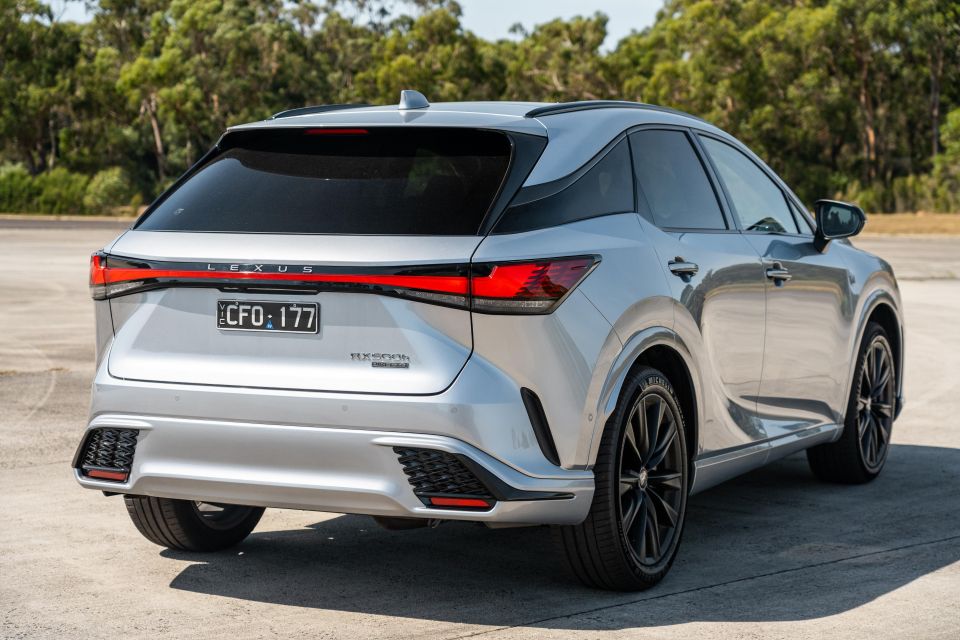

Quickly see how this car stacks up against its competition. Select any benchmark to see more details.
Where expert car reviews meet expert car buying – CarExpert gives you trusted advice, personalised service and real savings on your next new car.
The latest Lexus RX is one of the most important new launches for the Japanese luxury brand, because it’s up against some very tough competition.

While large luxury SUVs don’t quite do the volume of their mid-sized counterparts, the segment is incredibly competitive and arguably sets the tone for a brand’s broader range. Think of the BMW X5, for instance.
The RX has long been one of the most popular Lexus models, as well as a competitor to the likes of the X5, Mercedes-Benz GLE, Jaguar F-Pace, Range Rover Velar, and Volkswagen Touareg.
This new generation launched locally earlier this year, replacing an ageing predecessor that was a stalwart of the segment, and remained a popular choice for affluent Australian families right up until the end of its life.
With this overhaul, Lexus has made the five-seat RX bigger, lighter, and more electrified. The seven-seat RX L – an Audi Q7 and Volvo XC90 rival – is yet to be directly replaced, though a large three-row SUV based on the Toyota Grand Highlander is reportedly in the pipeline.
With fresh Toyota New Global Architecture (TNGA) underpinnings and a turbocharged petrol-electric drivetrain in the 2023 Lexus RX500h F Sport Performance tested here, the new RX promises to be the most luxurious, tech-laden and dynamic iteration yet.
In particular, the F Sport Performance model on test aims to offer more than just sporty looks and trimmings, rather bringing a driving experience that should break away from the taxi and hire car reputation that plagues some of Toyota and Lexus’s hybrid models.
But, at $126,000 before on-roads, this flagship Lexus RX is right up there in the thick of it with established segment benchmarks. Can it justify that price?
The RX500h F Sport Performance AWD is $126,000 plus on-road costs – $11,000 more expensive than the decked-out RX350h Sports Luxury AWD with all the Enhancement Packs.

That comes with a pretty decent bump in performance as well as mechanical changes and extra kit, but there’s no denying that’s still a healthy wad of cash.
Despite this, the RX500h F Sport Performance is a top-spec model priced in line with mid-spec or even entry versions of rival models from German rivals, which in relative terms plays to Lexus’s value-focused pitch.
An Audi Q8 50 TDI S line will set you back $133,800 these days, while an updated xDrive30d M Sport is now the entry point into the BMW X5 range at $134,900. The petrol xDrive40i is even dearer at $138,900 for the facelift due later this year.
Want a Benz? The GLE300d is a pricey four-cylinder alternative at $120,500, while the inline six-powered GLE450 starts from $135,200.
Other options include the Jaguar F-Pace 400 Sport ($128,450), the base Porsche Cayenne ($134,300), and the Volkswagen Touareg 210TDI R-Line ($117,540). All prices exclude on-road costs.

2023 Lexus RX pricing:
Prices exclude on-road costs
Buy your new car without the stress. It's fast, simple and completely free.

Great service from Travis and team, second time I have used this business would not hesitate to recommend them to anyone
Craig C.
Purchased a Ford Ranger in Sunshine Coast, QLD
CarExpert helped Craig save thousands on his Ford Ranger, now let us save you on your next new car.
Find a dealThe new RX is a world away from the old one inside.

The new RX addresses my gripes about some of the material quality in its smaller NX sibling and gives the new RX an interior worthy of a flagship Lexus – mostly.
Our test car’s Dark Rose perforated leather-accented trim is gorgeous, and really makes parts of the cabin pop thanks to the array of surfaces trimmed in the same hue. If it’s a bit too much for your liking, there’s black available too.
There’s actual aluminium trim pieces littered throughout as well, which is a nice touch, and metal is also used on the sports pedals.
Lexus also has a knack for making great steering wheels, particularly for F Sport models, and the overall design of the tiller here stays largely true to that.
The fat rim, trimmed in lovely perforated leather, feels beautiful in the hand and has some heft to it. It has an attractive design and nicely finished switchgear, but the actual buttons themselves aren’t my favourite.


For some reason Lexus is going hard on these fiddly touch-capacitive steering wheel controls with configurable shortcut menus, which projects onto the windscreen via the colour head-up display.
It seems cool and techhy in theory, but it’s fiddly in practice. Once you set your desired set of shortcuts it’s a little better, but there’s still a strong chance the controls may not work as well as hard buttons for you, as I found out.
When the switches haven’t been used in a while, it takes two presses to access the function you’re trying to activate. You often find yourself focusing on the HUD and not the road to make sure you’re pressing the right thing, which can be distracting.
Oddly, the Lexus range persists with a basic 7.0-inch TFT instrument cluster – F Sport and Sports Luxury models get a ‘High Grade’ version, apparently – rather than the fully digital binnacle that we’re starting to see in Toyota models as well as the bulk of the RX’s direct competition.
I’m also not sold on the fiddly interior door handles, which are small levers that double up as buttons, though aren’t always immediately obvious. I had several friends and family members lament their unconventional design.

The huge central touchscreen will no doubt catch your eye the moment you hop in and turn the RX on.
Measuring 14-inches, the display is easily one of the largest in class, and does away with Lexus’s old, infuriating touch controller that plagued its previous-generation products.
It runs the brand’s latest user interface and software, which does little to distinguish itself from its Toyota origins these days with the exception of the colour scheme. While simple, it’s well feature and largely works well.
Load times are snappy and responses to touch inputs are equally responsive; though I’d note the size of the display means reaching over for some menus while driving isn’t that user friendly.
In addition to embedded navigation, there’s wireless Apple CarPlay, wired Android Auto, DAB+ radio, and a three-year subscription to Lexus Connected Services – allowing owners access to emergency call, automatic collision notification, as well as remote functions via the Lexus Connected app.
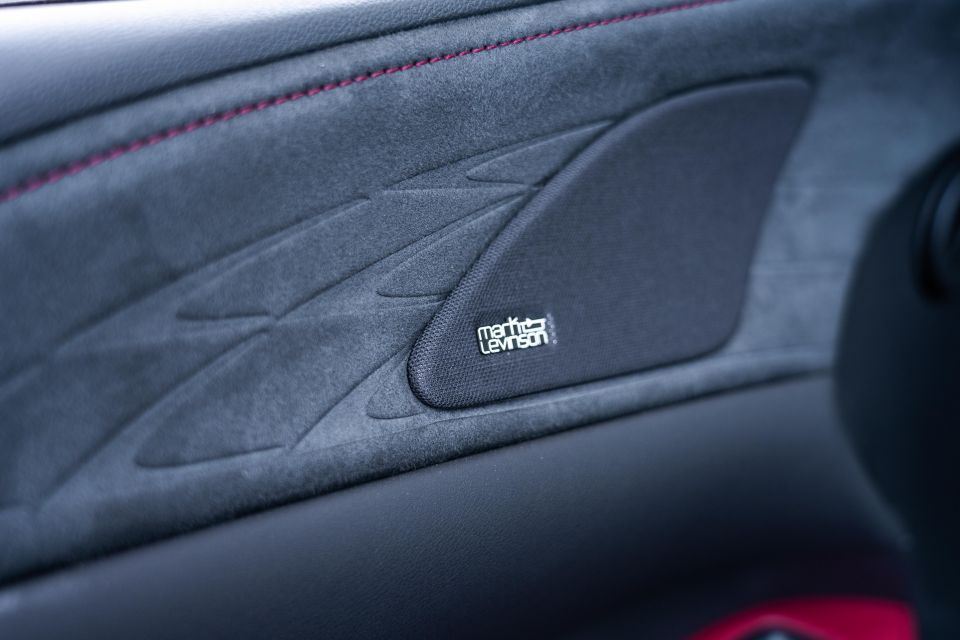

There’s also a voice assistant accessed by saying “Hey Lexus”, which features natural voice recognition.
It all works well, even if it’s a little too close to the interface used in the latest Toyota models. In typical Lexus fashion though, there’s a highlight few rivals can match – the audio system.
The RX500h F Sport Performance scores the 21-speaker Mark Levinson surround sound system, which as with previous iterations is a benchmark for sound quality.
Dial up the volume and bass, and you’re cocooned in what feels like a rolling recording studio. It’s impressively crisp, and has a depth to the sound that feels particularly high end. Bravo.
Storage up front is decent, with big toothed cupholders and an array of storage nooks and shelves for your stuff. There’s a big cubby under the front-centre arm rest too, and the door pockets are quite spacious.




The RX’s increased size in just about every dimension has made for improved passenger space in the rear, which was a criticism of the previous generation.
A 60mm increase to the wheelbase (2850mm) brings a welcome gain in second-row leg and knee room, though the RX still feels a bit cosier in the back compared to something like a Volkswagen Touareg, especially if you have front occupants of above-average height.
F Sport and F Sport Performance models also unfortunately miss out on heated and ventilated outboard rear seats, as well as the power-folding rear seat backs exclusive to the Sports Luxury. Given the price, they’d be nice.
You do get a third zone of climate controls with directional vents though, as well as USB-C points to keep devices juiced. Rear map pockets and bottle holders in the doors feature, as well as a chunky fold-down rear centre armrest with a storage cubby and cupholders, which feels built to last.
ISOFIX anchors are fitted to the outboard seats, and there are top-tether points across the backs of all three rear seats. Kids should be more than happy in the back, and there are manual sunshades to block out the haters.


Another area where the new RX has grown significantly is in the boot, where it now offers 612 litres of volume with the second row in place, or 1678 litres with the rear seats folded.
That’s well up on the previous generation, which quoted 453 litres and 924 litres respectively for the same configuration, and almost matches the outgoing RX L (652L).
However, it’s still behind the likes of the Volkswagen Touareg (810L-1800L) and BMW X5 (650L-1870L).
The RX500h debuts a new turbocharged hybrid drivetrain for Lexus, based around a 2.4-litre turbocharged four-cylinder petrol engine similar to the one you’ll find under the bonnet of the RX350.

On its own the turbo petrol engine develops 202kW (6000rpm) and 460Nm (4300-4500rpm), and is teamed with two electric motor-generators – a 64kW/292Nm unit on the front axle and an additional 76kW/169Nm unit at the rear.
Lexus quotes a system output of 273kW, and in typical fashion doesn’t quote a system torque figure. The e-motors are hooked up to a 288V nickel-metal hydride battery pack. Zero to 100km/h takes a claimed 6.2 seconds, which is hot hatch territory – not bad for a 2160kg (kerb) SUV.
Now for some of the more technical parts. The transmission is not an e-CVT like you’ll find in other Toyota/Lexus hybrids, rather there’s a six-speed automatic transmission on the hybrid front transaxle with a wet start clutch, which the company says acts as the starting mechanism in place of a standard torque converter for “smooth off-the-line performance”.
When the engine is running, the start clutch and a second clutch are engaged, combining the engine and front electric motor-generator torque and transmitting it to the front wheels. In EV mode, the wet start clutch sends motor-generator torque to the front axle, while the e-motor at the rear facilitates electrified all-wheel drive.

Lexus says the variable all-wheel drive system – dubbed DIRECT4 – can offer torque distribution from 70:30 front-rear to 20:80 depending on the conditions and driver inputs, which allows for “faithful steering inputs that help reduce oversteer and understeer”.
The electric motors also work to eliminate turbo lag, and combined with the Lexus-first separate two-port vane oil pump and high-voltage electric oil pump on the front transaxle claim to improve fuel economy.
Official combined fuel consumption is a quoted 6.5L per 100km on the more lenient NEDC test cycle, with average CO2 emissions rated at 148g/km.
The drivetrain is homologated to Euro 6B emissions regulations, and requires 95 RON premium unleaded fuel. The RX500h runs a 65-litre fuel tank, which means a theoretical 1000km of range per fill based on official consumption.
It’s also rated to tow up to 1500kg (braked).
The F Sport Performance comes with big hype, so I was keen to see whether it lived up to the promise.

You’ll notice early on that the RX500h isn’t like other hybrids in the Toyota-Lexus stable. It drives quite differently and gives you the impression it’s much more about performance and engagement from the get-go.
It’s keener to lean on its turbocharged petrol engine than regular Lexus and Toyota hybrids, and having an actual six-speed transmission means you won’t see it flaring revs like you would with vehicles using a CVT.
Response in town is quite good. The immediacy of the e-motors’ torque means you get rolling quickly and smoothly, and the petrol engine will kick in under heavier throttle inputs or about 20km/h and get rolling quicker again.
There’s a synthetic engine noise pumped into the cabin under throttle to disguise the electrified underpinnings, and it’ll play at varying levels depending on the drive mode selected and the level of throttle input.
It’s quite satisfying to punt at the lights, and getting up to freeway speeds barely breaks a sweat. While the 500h and F Sport Performance branding may suggest AMG or M levels of performance, the way the RX500h performs is more in line with mid-tier options in rival ranges.

Where expert car reviews meet expert car buying – CarExpert gives you trusted advice, personalised service and real savings on your next new car.
Don’t get me wrong, this thing is quick and feels it, but the 6.2-second 0-100 time is barely on par with rivals featuring six-cylinder turbo-diesel engines, let alone those with turbocharged or supercharged six-pot petrols.
In a straight line it hustles and it’s so beautifully linear that it’s often going quicker than you realise, but this won’t be a more attainable substitute for a Porsche Cayenne GTS or BMW X5 M60i. The augmented engine sound also can’t hide the 2.4-litre turbo’s buzzy note under heavy load.
From a handling perspective, the RX500h has a number of cool features to keep it stuck to the blacktop and offer more direct response, but there’s no disguising its heft nor the fact this isn’t a proper performance SUV.
There’s an upright, lofty feel from the driver’s seat and that long nose can at times make it feel boaty, particularly in tighter bends. It points and turns in pretty well, though, even if the steering feel is a little light and numb at best.
The rear-wheel steering system helps to improve manoeuvrability at low speeds by turning the rear wheels up to 4.0 degrees opposite to the fronts to tighten the turning circle, while at higher speeds it turns them in the same direction to enhance stability.
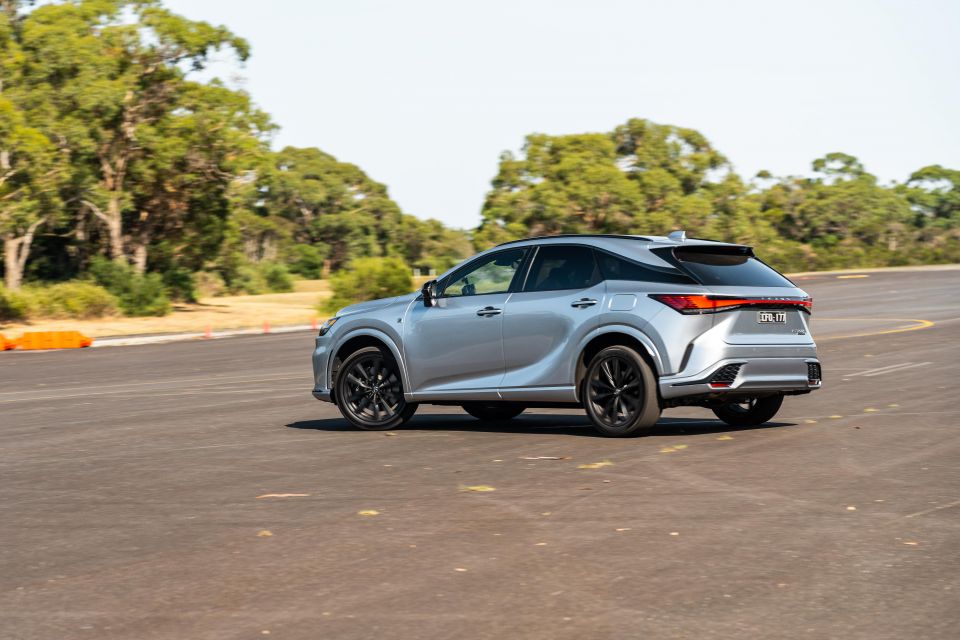
I can’t fault the sure-footedness of the RX500h in the variety of weather conditions and environments I encountered during my time with the car. Like you’d expect of a big luxury SUV, it has excellent stability and grip across the board, which inspires confidence whether you’re on the school run or a winding B-road.
The combination of a conventional six-speed automatic and hybrid transaxle with wet start clutch is fairly well sorted, with snappy shifts, smooth take-off and a near seamless shift between petrol, electric and hybrid power where applicable.
I found the RX500h had a habit of really leaning on the petrol engine so it drove more like an electrified petrol vehicle with assistance under load and at parking speeds, which is a win if you don’t like the CVT feel of other Toyota-Lexus hybrids but not so much of a win if fuel consumption is a high priority.
Our test car was constantly running in hybrid mode rather than EV mode even in its Normal and Eco drive modes, and didn’t seem to want to engage EV drivetrain mode above 70km/h – much like the old RX450h with its hybridised V6.
While it meant you had all its performance on tap most of the time, a week’s worth of commuting to and from the office in peak-hour traffic meant real-world fuel consumption was actually quite poor, especially given the latest TNGA trend of achieving excellent efficiency.
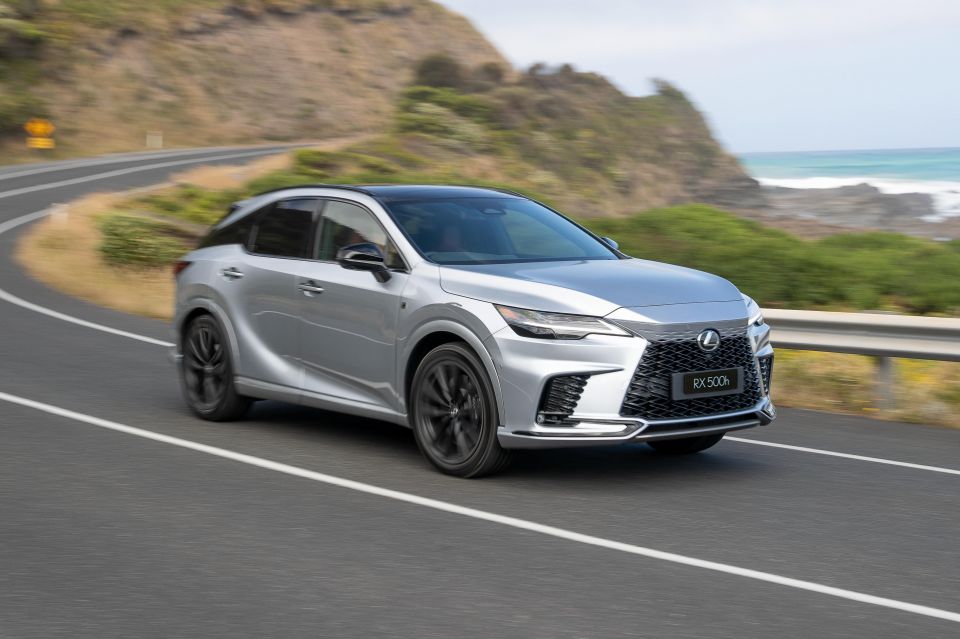
We ended the week with an indicated figure of 10.7L/100km, and saw as low as 9.0L/100km at certain points during the week – well up on the manufacturer’s combined claim of 6.5L per 100km.
I contacted Lexus Australia to see if there was perhaps anything wrong with the vehicle, given it seemed to not want to lean on its electrified components as much as we expected, but at the time of writing we’re under the impression the vehicle was operating as intended.
Yes, this is the F Sport Performance with a greater focus on straight-line go than your usual hybrid, but it’s disappointing the RX500h can’t even match the efficiency of diesel-powered competition.
In normal scenarios the RX500h is at least a quiet, comfortable and refined thing to cruise in, as you’d expect of a Lexus.
The adaptive damping does a great job of ironing out the lumps and bumps of daily driving even with 21-inch alloy wheels, and offers a level of adjustability to tailor the chassis to your liking as well as the driving environment, if not quite as plush as some air-sprung rivals.
Further, it’s impressively hushed over most surfaces across all speeds, though I will note those big ol’ wheels and Michelin Pilot Sport 4 performance tyres to transmit a bit of road roar into the cabin over rougher black top.
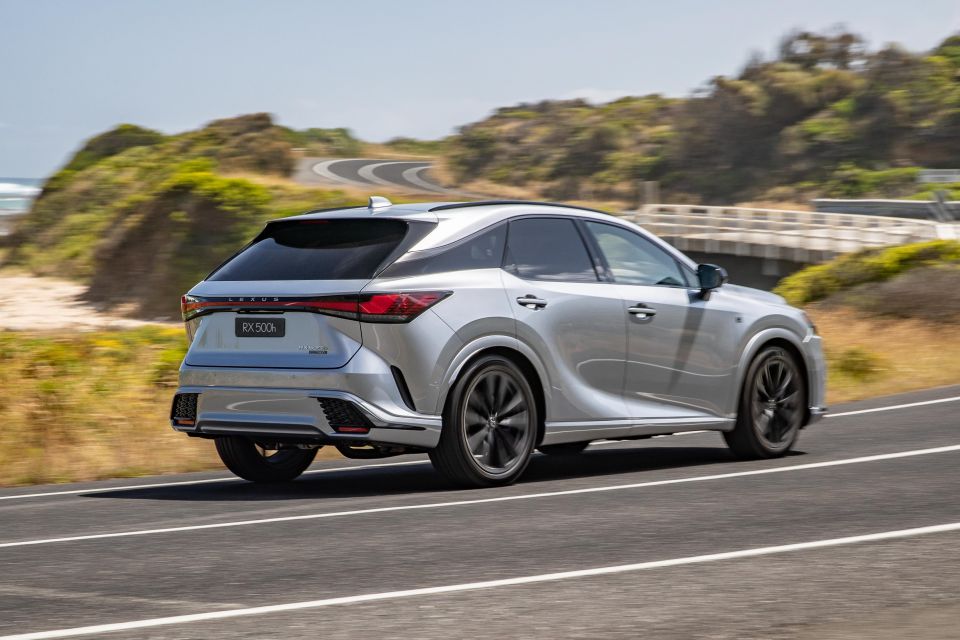
The RX’s range of assistance systems are also points for praise.
All-speed adaptive cruise control and Lane Trace Assist combine to facilitate semi-autonomous highway driving, and are accessed via a button on the steering wheel – like VW’s Travel Assist mode. Once activated, it’s smartly calibrated and not overzealous like Toyota-Lexus systems of old.
Blind-spot monitoring and rear cross-traffic alert come in handy with the RX’s rakish tailgate and thick D-pillar design, and the Panoramic View Monitor makes parking this big 4890mm long and 1920mm wide bus that little bit easier – and should stop you scraping those 21-inch alloys.
The RX500h also gets the flagship tri-projector LED headlights with BladeScan tech, which effectively apes a Matrix LED unit with adaptive high-beam. It offers bright and crisp illumination, and when left in its auto setting does all the hard work for you without dazzling oncoming road users.




RX350h Luxury highlights:
Enhancement Pack ($5100 FWD, $5500 AWD) adds:


RX350 F Sport adds:
The $3000 Enhancement Pack 1 adds a panoramic sunroof, while the $1100 Enhancement Pack 2 adds a digital rear-view mirror, semi-automatic parking assist, and a heated steering wheel.
RX350 Sports Luxury and RX350h Sports Luxury add (over Luxury):
The $3000 Enhancement Pack 1 adds a panoramic sunroof, while the $900 Enhancement Pack 2 adds a digital rear-view mirror and semi-automatic parking assist.


RX500h F Sport Performance adds (over F Sport):
Following its launch in Australia, the Lexus RX received a five-star ANCAP safety rating based on Euro NCAP tests conducted in 2022.

The rating applies to all variants – which includes petrol and hybrid powertrain variants.
It scored 90 per cent for adult occupant protection, 89 per cent for child occupant protection, 89 per cent for vulnerable road user protection, and 93 per cent for safety assist.
“The Lexus RX is another of our top performers – achieving high scores across all key areas of assessment resulting in a five star ANCAP safety rating,” said ANCAP chief executive, Carla Hoorweg.
Standard safety features include:
RX Sports Luxury adds:
The Lexus range is covered by a five-year, unlimited-kilometre warranty.
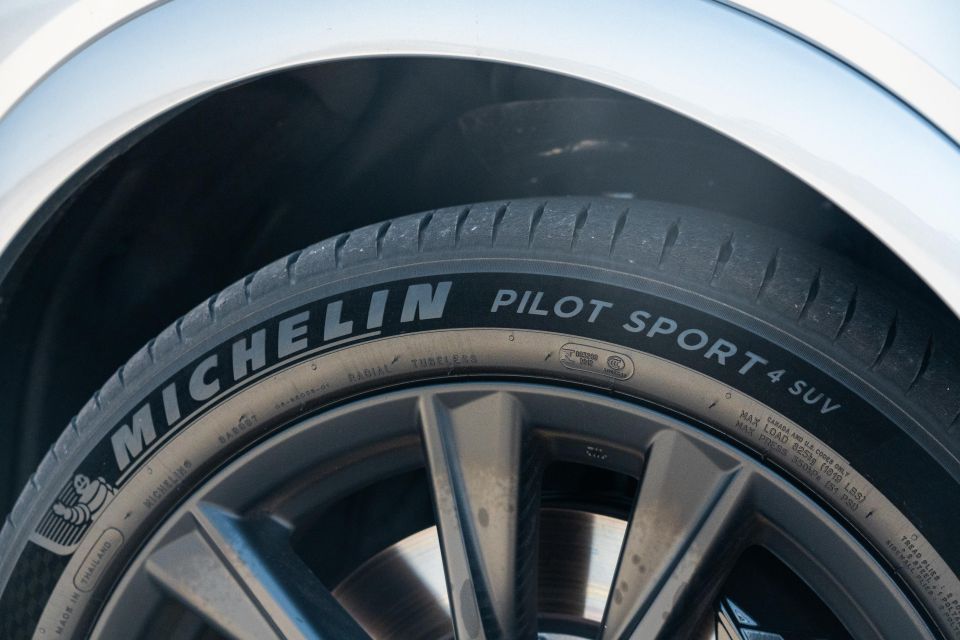
Maintenance is required every 12 months or 15,000 kilometres – whichever comes first. The first five services will each set you back $695 apiece under the Lexus capped-price service program.
You also get access to the Lexus Encore ownership program, which gives owners access to Caltex fuel discounts, invitations to luxury dinners and events, as well as luxury hotel partnership benefits.
Lexus Australia is also rolling out a new smartphone app that lets owners track and check up on or control aspects of their vehicle from the couch.
The RX500h F Sport has a lot going for it, but I just don’t feel like it delivers on all its promises.

Yes it’s fast, yes it’s luxurious, and yes it’s a family SUV that you could live with every day. Would I say this is a genuine alternative for other more performance-focused luxury SUVs? Probably not.
There’s a few disjointed elements to the RX’s driving experience that leave it without that final layer of polish to be a top choice in my books. It’s not quite quick or sharp enough to match an AMG 53 or M Performance, let alone something with a Porsche badge, nor is it efficient enough to justify its hybrid promise.
On paper the RX500h F Sport Performance should have the makings of greatness, but in reality feels a bit undercooked.
It’s the best RX to drive that I’ve experienced, and certainly has a level of performance never seen before in the nameplate’s history, but I just wouldn’t go into the Lexus showroom thinking this is going to outshine a Porsche Cayenne or Jaguar F-Pace with its dynamic talents, nor a BMW X5 with its cabin presentation.

It’s a shame, because the RX’s sexy looks and muscular performance are otherwise desirable, and the long features list and proven reliability are draw cards for those wary of owning a European rival outside of the warranty period.
With that said, and like most Lexus products, you’re better off shopping at the lower end of the range for one of the 350h hybrids, as they’re far better value and more competitive within the segment. The $126k asking price for this 500h F Sport Performance seems a little too steep, even if it shows glimpses of greatness.
My tip? Get a 350h Luxury with the Enhancement Pack if you want one of the best-value large luxury SUVs on the market, or nab yourself a 350h Sports Luxury with Enhancement Pack 2 if you want the absolute best in luxury and tech the RX line-up has offer.
Otherwise, the Volkswagen Touareg 210TDI R-Line has similar punch from its six-cylinder diesel as well as better real-world efficiency, and has more passenger and cargo space to counter its inferior cabin quality compared to the Lexus. Perhaps a future head-to-head comparison is on the cards…
You’ll be saving yourself thousands compared to the 500h F Sport Performance, which you wouldn’t have in your driveway for over 12 months if you ordered tomorrow anyway.

Click the images for the full gallery
MORE: Everything Lexus RX
Where expert car reviews meet expert car buying – CarExpert gives you trusted advice, personalised service and real savings on your next new car.
James Wong is an automotive journalist and former PR consultant, recognised among Australia’s most prolific motoring writers.


William Stopford
18 Hours Ago


William Stopford
19 Hours Ago
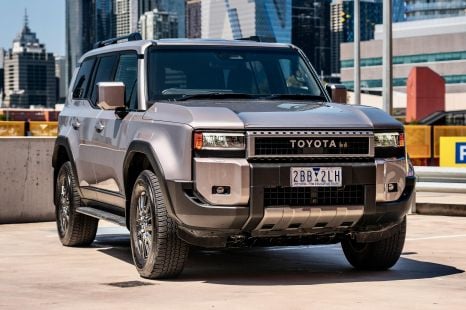

William Stopford
19 Hours Ago


Max Davies
1 Day Ago


William Stopford
2 Days Ago


Josh Nevett
5 Days Ago